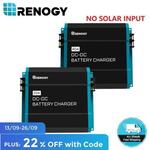I took the $$ off based on all the following promotions
https://www.ozbargain.com.au/node/724371
https://www.ozbargain.com.au/node/725793
I used a 10% off GIFT card bought previously
$149.99x78%x90% - $20 = $85.29 $149.99-$85.29 = $63.71 63.71/149.99=42.48% off
Not sure if I can get the further %4 off from shopback?





is Renogy just glorified Chinese made (as everybody else) more expensive brand? what are your thoughts?